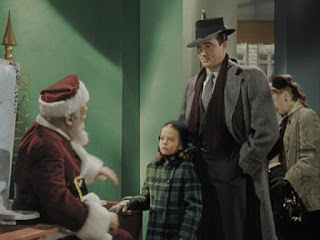 |
| My Man Godfrey (1936) colorized |
By the 1980s, it became an attempt to revive beloved films of the golden age of Hollywood and present them to a newer audience who were dismissive of the original format. In 1985, a colorized version of the classic Miracle on 34th Street (1947) was aired on television and received higher ratings than the original unedited version shown in previous years.
As decades and technology progressed, black and white films were gradually replaced with vibrant colors. No one option was better or worse, as the pictures created during each decade reflected the artistic decisions of the directors and the advancement of techniques. Some studios even resorted to shot for shot carbon copies of original classics to appeal to a modern audience. 1998 would see Hitchcock's legendary Psycho (1960) remade scene for scene, a project that ultimately ended up flopping.
 |
| Miracle on 34th Street (1947) colorized. From ginger-peachy.com |
In 1987, Ginger Rogers, among several other members of the entertainment industry, even joined forces to testify before the Senate Subcommittee on Technology and Law against the colorizations of authentic black and white films. Witnesses argued that coloring a film is a way of defacing an artist's work. Their goal was simply to protect the basic rights of the artist, who are in this case the directors, and prevent their works from becoming victim to the dreaded "Easter egg dye" without their consent.
Director John Huston was mortified at the colorized fate of one of his most celebrated works, The Maltese Falcon (1941). In 1986, he stated: "I think it's a desecration. It's an absurdity. It's a demonstration of the will to corrupt the taste of the multitude."
"Why would anyone wanna turn these great looking films into color? Simple. To make money. People have loved great looking films like Casablanca just the way they are for more than 40 years. I don't think they're going to love them any more in color." -Leonard Maltin, 1986
Of the over 70 films that Ginger Rogers completed throughout her expansive career, only 7 of them were made in color. At the 1987 hearing, she testified, "I would like to tell you how it feels as an actor to see yourself painted up like a birthday cake on a television screen. It feels terrible. It hurts. It's embarrassing and insulting. As actors we are very concerned about our appearance on the screen. Our appearance and expressions are the tools we use to create a character on the screen. It is a subtle and sensitive art that is completely obliterated by computer coloring."
At the hearing, Ginger also read aloud a letter from respected actor Jimmy Stewart, in which he stated: "Why do it? Except to make some quick money on someone else's work. The colorized version [of It's A Wonderful Life (1946)] was shown on TV last year. I watched half of it and had to turn it off. I couldn't get through it. The artificial color was detrimental to the story, to the whole atmosphere and artistry of the film. When I think of Frank Capra's fine cameraman, Joe Walker, and the time he spent on the delicate lighting and built in shadow of It's A Wonderful Life, and to have that work wiped out by computerized color, which destroys the delicate shadows and depths of each scene, it makes me mad."
 |
| Ginger at the 1987 hearing |
So, what's your view on the coloring of black and white films? Do they offer a new way to introduce future generations to the classics, or are they simply an insult to that era of Hollywood artistry itself? Take into consideration this quote from Ginger Rogers during the 1987 hearing, "Our black and white films ain't broke, and they don't need fixin'."
© Saga of Ginger and sagaofginger.blogspot.com 2018 Unauthorized use and/or duplication of this material without express and written permission from this site's author and/or owner is strictly prohibited. Excerpts and links may be used, provided that full and clear credit is given to Saga of Ginger and sagaofginger.blogspot.com with appropriate and specific direction to the original content.

This work is licensed under a Creative Commons Attribution-NonCommercial-NoDerivatives 4.0 International License.






.jpeg)




They don't need to add color to classic films. They are perfect just the way they are!!!
ReplyDeletePlease don't color classic films. I grew up watching black and white tv. I love the classic films just the way they are. I just hated the color verison of,Miracle on 34th Street. When it comes on tv now i don't watch it. I wait untill they show the original black & white verison. Please don't mess with the classic films.
ReplyDelete